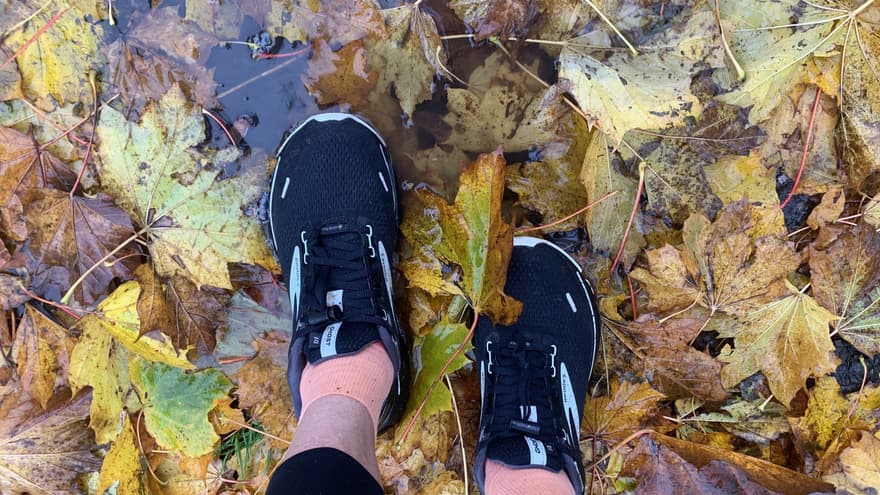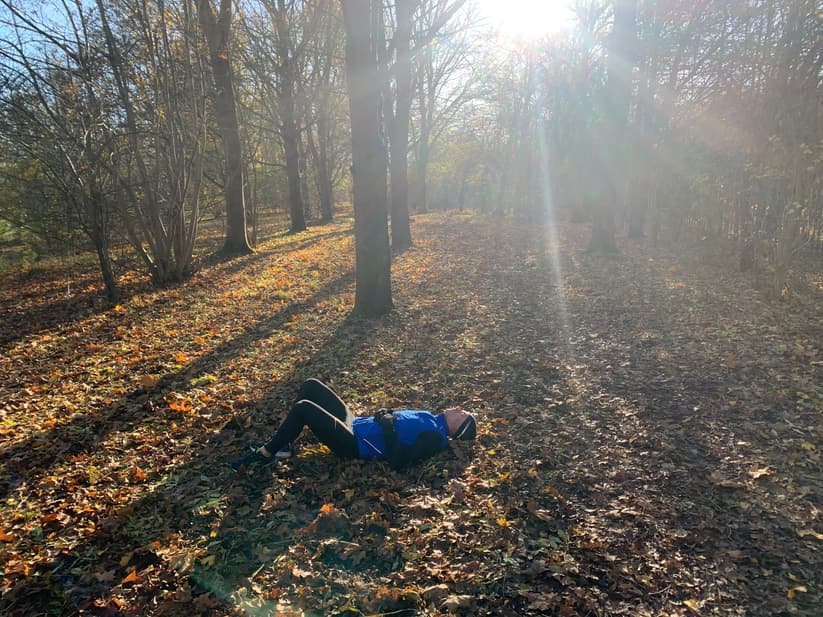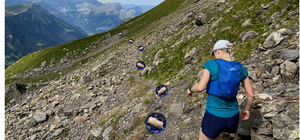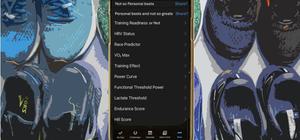6 December, 2023
Rest days are not just about putting your feet up because there is a lot more you can do to help you keep fit and stay healthy this winter.

As we head into winter and the weather becomes more predictably cold, wet and windy, it can get a little bit more difficult to motivate yourself to get outside to exercise.
After all, when the roads and pavements seem to be permanently covered with fallen leaves, even a short venture out can feel like you have gone on a cross-country trek. Not to mention that you will likely return home far soggier than you expected and will then have to dig out copious amounts of foliage and twigs wedged into every tread of your shoes.
Luckily, the physical and mental health benefits of exercising outdoors are so immensely rewarding that many people don’t just put up with the bad weather. They are willing to do it all again. And provided you have the right kit and can be comfortably weather-proofed, there is nothing to stop you from enjoying the great outdoors all winter.
However, there is another key factor that is often overlooked but it is actually an essential part of staying fit and healthy when the elements are testing your limits. Focusing on it can make the difference between being able to stay active outside this winter or having to nurse a cold while you wait indoors until the spring. One of the best ways to build up your strength and resilience is to prioritise your recovery days more.
The importance of having a rest day is hardly ever mentioned in the fitness forums and training plans that most people subscribe to. Perhaps it’s because when it comes to exercising and increasing your fitness, it almost seems counterintuitive to be thinking about rest.
And why would anyone need to think about their rest days when having one is pretty much self-explanatory? Knowing how to rest is not exactly rocket science. However, having a rest day is not necessarily the same thing as having a recovery day and there is a lot more you can do to help yourself recover than simply not working out.
A recovery day is all about using the time better to recharge your body, so that you are in the best possible shape to get back out there again. And the two chief factors that are absolutely fundamental to making a full recovery are resting proportionally and refuelling with good nutrition.

Starting with the first important ingredient, there is a very simple reason why rest must always be a part of a good recovery day. You will be tired! Primarily this is because as we exercise, our muscles are strained and they will suffer a countless number of tiny microtears.
Since our bodies can only rebuild and repair the microtears with time, resting is essential to completely recover. However, this doesn’t automatically mean you need to sprawl out on your couch all day as much as most people would like to.
Clearly there is a big difference in the tiredness you will feel when you have a rest day within a regular week of exercise and when you have one after you have taken part in some epic event. In other words, the type and the intensity of exercise you have been doing will dictate how much time you actually need to spend putting your feet up.
This is why resting proportionally is a far more effective way to recover, as you may actually benefit more by including a little ‘active rest’ as part of your recovery day. Active rest can allow your body to recover while reducing stiffness from complete inaction and can help relieve the dreaded DOMS (delayed onset muscle soreness).
But doing active rest doesn’t mean simply repeating more of the same exercise you’ve just been doing and straining the same muscles. Instead, do some stretching, do yoga, go for a walk or even take part in a different sport provided it is low intensity. Doing some active rest sensibly also means preventing yourself from becoming overtired so you can recover fully.
The important thing to remember is to really listen to your body rather than ignoring any signs of tiredness or restlessness. Sleeping well also plays an important part in resting for a good recovery, so avoid having late nights and consuming caffeine too late in the day.
Although factoring in enough rest time from doing exercise will help your body recharge itself, it is simply not enough on its own. The second key factor that is crucial to having a full recovery is refuelling and nourishing your body with good nutrition. It is safe to say that most people are aware of the importance that a nutritious diet makes to their overall health and wellbeing.
And those who exercise regularly will also know that eating healthily and a having good diet will provide you with the right fuel to do sport. However, for some reason many of these same people tend to forget about their diet whenever they are on a ‘rest day’. Even worse, some will purposely cut back on their meals or omit entire food groups in the belief that they need to eat less calories because they are not exercising.
However, if you do not allow your body to refuel sufficiently from doing exercise, then it cannot possibly fully recover. This means that even if you are well-rested, if you haven’t sufficiently refuelled, you will be more tired and vulnerable when you go out in the winter weather. This will put you at a higher risk of illness and even injury.
As it is harder and more tiring to exercise when your body is trying to run on a deficit of calories, you may end up needing an even longer period of recovery time than you planned. But if you use your recovery day to ensure that you have refuelled your body properly, you will be much more likely to stay healthy and get active outside sooner.
ALthough refuelling well doesn’t mean you should park yourself in front of the nearest all-you-can-eat buffet. Again, there are regular workouts and then there are marathon feats. It’s not just about simply replacing the calories you used up from exercising. Our bodies are better at storing and using some fuel for energy more than others. Ultimately, carbohydrates are king.
Carbs are our body’s preferred fuel to use for providing power and long-lasting energy for our muscles, brain and the central nervous system. Clearly, we need all these to be functioning well to do any exercise!
The carbohydrates in the food we eat are broken down and stored as glycogen in the body. As we exercise, the glycogen is used up as energy but the rate it is depleted at will depend on the type, intensity and duration of the exercise. Since our bodies have a limited store of glycogen we need to replace it again by eating.
Although you almost certainly would have eaten after exercising and replaced some of the carbohydrates you lost, your body will still be able to store more carbohydrates up to 24-48 hours afterwards.
This makes a recovery day an ideal time to refuel with some more. By including plenty of sources of healthy carbohydrates you will help to ensure that your stores are sufficiently topped up to fuel your next workout. In terms of what type of carbohydrates you should be reaching for, choose wholegrain starchy complex carbohydrates such as wholewheat pasta or bread, brown rice, potatoes, sweet potatoes, couscous, or other grains and cereals.
Of course, don’t forget that the carbohydrates in fruits and vegetables will also contribute to this fuel in addition to being great sources of vitamins, minerals and fibre.
In addition to refuelling with carbohydrates, it is also important to include some healthy sources of protein. Protein is used for the growth, development and maintenance of our health and chiefly, building and repairing muscles.
Since protein is needed to repair the microtears caused by exercise, if your diet does not contain a sufficient amount, you will lose muscle mass over time. Having said that, the vast majority of people eat far more protein than their actual requirements, even if they also exercise intensely.
So it is better to focus instead on the quality of the protein in your diet and aim for healthy sources that are low in saturated fat and salt. Some healthy protein sources you could choose include beans, pulses, tofu, nuts, fish, eggs, Quorn and poultry. You can also find good sources of protein in dairy products such as lower and fat-free milk, cheese and yoghurt.
There are an endless number of options when it comes to healthy meal ideas to eat on a recovery day. But the golden rule to stick to is to base your meals on healthy carbohydrates, a good source of protein and plenty of fruit and veg.
Some easy options could be wholewheat pasta with tuna and tomato, a stir fry with vegetables, tofu and brown rice, a jacket potato or sweet potato with veggie chilli, or any hearty soup or stew with lots of chunky bread. You may also find it helpful to cook more than you need to on your recovery days, so you can then freeze the leftovers for busier times ahead.
After all, there is nothing better than returning from a wet and wintery workout knowing that you have some great leftovers on hand that you can simply defrost and heat up in minutes.
Lastly, we may have some long months ahead of us in another cold, wet and windy winter, but don’t let that put an end to exercising outdoors. You can stay fit and healthy all winter long just by using your recovery days more effectively.
Remembering to rest proportionally and refuelling yourself with a nutritious diet will allow your body to recover fully. Which is why recovery days are an essential part of building your resilience to the cold weather and prioritising them more can help you enjoy the great outdoors all winter long.
Here's a great recovery meal and winter warm up because I think there is nothing better to put your hands around then a nice bowl of Smoky carrot and yellow pea soup with spinach and smoked almonds.
I am originally from Canada but I settled in the UK after studying at university. Sports have always been a part of my life and I have participated and competed in several throughout my childhood. But today I would describe myself as mostly a runner, a mother of 3 grown-ups and a keen cook. As a teenager I was a sprinter and a slightly reluctant cross-country runner but while my children grew up I started to run further and further distances. I never thought that I could ever run anything longer than a half marathon but when my runner husband decided to do a marathon for his 50th in 2019 I found that I had a serious case of FOMO. My children encouraged me to sign up for my first marathon and I ran it just to see if I could finish. Somehow my time was good enough to qualify for the Boston 2020 Marathon. However, due to Covid it was postponed several times.
Like many other runners, I spent much of my time in the Covid lockdown keeping up my fitness by participating in virtual races while waiting for the real events to start up again. As time went on I found myself becoming fully immersed in the world of endurance running and ran the Threshold Trail Series ultra, Race to the Stones. Unfortunately, by the time the Boston Marathon was finally held in late 2021, I could not go because US travel restrictions were still in place. Although I missed my chance to run it and will now have to requalify again at least my time spent keeping in good shape wasn’t wasted. These days I participate in everything from half marathons up to ultras and have also run the Great Glen Way and West Highland Way in the Scottish Highlands.
I also work as a Registered Nutritionist with children and families and founded the consultancy Just add water® in 2019. I write a blog at https://justaddwaterblog.com/ to give free information and advice about nutrition and running whilst also sharing some of my favourite healthy recipes. The website is mainly aimed at busy families who want to make easy to prepare meals that are both healthy and really tasty, and for active families who want to know what they should be eating before, during and after playing sport.
I have always enjoyed cooking and previously cooked as a profession and I like to share my passion for good food. I have been involved in teaching cookery in schools, children's centres and for the NHS. I also enjoy entering the odd competition to push myself out of my comfort zone. I was awarded Highly Commended at the Teflon™ Diamond Standard Awards 2020 national culinary competition in the category of Keen Home Cook and was a National Finalist in 2022 & 2019. I have also had my recipes published in The Guardian's supplement, Cook; and featured in the 2012 Waitrose LOVE life calendar (July); and selected for inclusion in the 2020 #AnyWhichWayaBix Weetabix recipe book.
Most recent articles by Suzanne Anderegg

The summer is coming…but why do so many runners still try to outrun their thirst?

Most adults know that food shouldn’t be used as a reward for our children’s achievements but for some reason we don’t think that this applies to ourselves. Especially among endurance runners because sometimes good food can be the best motivation to carry on.

Runners can get a bit obsessed about achieving their Personal Best but there’s more to a PB than simply stats.
Most recent articles in ADVENTURE

Want to meet up with like-minded adventurers, try some new activities and get inspired? Try these festivals in the UK.

In January 2024 I left my home in Manchester to travel around South East Asia. Running has played a huge part in my experience of each and almost every place I’ve passed through. But this type of behaviour hasn’t always been typical of me. No, in fact a couple of years ago, I’d have thought it bizarre to even think of running whilst on the trip of a lifetime, let alone actually follow through with it and worse still, enjoy it!

Universal Pictures Content Group and Dogwoof announce THE MOUNTAIN WITHIN ME will release in UK cinemas on 23rd August 2024, preview Q&A screenings will tour the country from 19 August 2024.